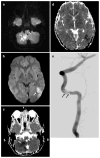Athletics, minor trauma, and pediatric arterial ischemic stroke
- PMID: 19760434
- PMCID: PMC2836396
- DOI: 10.1007/s00431-009-1066-1
Athletics, minor trauma, and pediatric arterial ischemic stroke
Abstract
Pediatric arterial ischemic stroke may occur as the result of trivial head or neck trauma sustained during a sports activity. We describe three cases of sports-related stroke in previously healthy school-age children and discuss acute and long-term stroke care. Possible mechanisms of sports-related stroke are addressed, as is evaluation for cause of stroke in children. In one of the reported cases, the child was found to have a vertebral artery dissection as the cause of his stroke, but no definitive cause of stroke was identified in the other two cases despite extensive evaluation. The advisability and timing of returning to athletic activities after stroke is also discussed. Many children with sports-related stroke are initially seen by a sports trainer, a pediatrician, or an ER physician. Thus, it is particularly important that these professionals are aware of the possibility of ischemic stroke occurring after even mild athletic injury. Childhood stroke may result from injuries sustained during athletic activities and should be considered when a child has acute focal neurologic signs.
Conflict of interest statement
Figures


Similar articles
-
Athletic participation after acute ischemic childhood stroke: a survey of pediatric stroke experts.J Child Neurol. 2007 Aug;22(8):1050-3. doi: 10.1177/0883073807306271. J Child Neurol. 2007. PMID: 17761660
-
Craniocervical arterial dissection: a cause of childhood arterial ischemic stroke in Taiwan.J Formos Med Assoc. 2010 Feb;109(2):156-62. doi: 10.1016/S0929-6646(10)60036-8. J Formos Med Assoc. 2010. PMID: 20206840
-
Cerebrum-cervical arterial dissection in adults during sports and recreation.Arq Neuropsiquiatr. 2016 Apr;74(4):275-9. doi: 10.1590/0004-282X20150150. Epub 2015 Oct 6. Arq Neuropsiquiatr. 2016. PMID: 26445125
-
Sports-specific injuries.Clin Sports Med. 1996 Apr;15(2):207-18. Clin Sports Med. 1996. PMID: 8726314 Review.
-
Treatment issues in spontaneous cervicocephalic artery dissections.Int J Stroke. 2011 Jun;6(3):213-8. doi: 10.1111/j.1747-4949.2011.00605.x. Int J Stroke. 2011. PMID: 21557808 Review.
Cited by
-
Vertebral Artery Dissection in Sport: A Systematic Review.Sports Med. 2019 Apr;49(4):553-564. doi: 10.1007/s40279-019-01066-0. Sports Med. 2019. PMID: 30758815
-
Post-traumatic ischaemic stroke in a teenager after head trauma: A case report.Trauma Case Rep. 2023 May 4;45:100835. doi: 10.1016/j.tcr.2023.100835. eCollection 2023 Jun. Trauma Case Rep. 2023. PMID: 37206626 Free PMC article.
-
Childhood arterial ischemic stroke: a review of etiologies, antithrombotic treatments, prognostic factors, and priorities for future research.Semin Thromb Hemost. 2011 Oct;37(7):786-93. doi: 10.1055/s-0031-1297169. Epub 2011 Dec 20. Semin Thromb Hemost. 2011. PMID: 22187401 Free PMC article. Review.
-
Cervical artery dissection after sports - An analytical evaluation of 190 published cases.Eur Stroke J. 2017 Dec;2(4):335-345. doi: 10.1177/2396987317720544. Epub 2017 Jul 10. Eur Stroke J. 2017. PMID: 31008325 Free PMC article.
-
Posttraumatic cerebellar infarction after repeated sport-related minor head injuries in a young adult: a case report.Neurol Med Chir (Tokyo). 2015;55(2):179-82. doi: 10.2176/nmc.cr.2014-0094. Epub 2015 Jan 23. Neurol Med Chir (Tokyo). 2015. PMID: 25746313 Free PMC article.
References
-
- Arauz A, Hoyos L, Espinoza C, Cantu C, Barinagarrementeria F, Roman G. Dissection of cervical arteries: long-term follow-up study of 130 consecutive cases. Cerebrovasc Dis. 2006;22:150–154. - PubMed
-
- Bernard TJ, deVeber GA, Benke TA. Athletic participation after acute ischemic childhood stroke: a survey of pediatric stroke experts. J Child Neurol. 2007;22:1050–1053. - PubMed
-
- Bernard TJ, Goldenberg NA. Pediatric arterial ischemic stroke. Pediatr Clin North Am. 2008;55:323–338. - PubMed
-
- Braun KP, Kappelle LJ, Kirkham FJ, Deveber G. Diagnostic pitfalls in paediatric ischaemic stroke. Dev Med Child Neurol. 2006;48:985–990. - PubMed
-
- Burger IM, Murphy KJ, Jordan LC, Tamargo RJ, Gailloud P. Safety of cerebral digital subtraction angiography in children: complication rate analysis in 241 consecutive diagnostic angiograms. Stroke. 2006;37:2535–2539. - PubMed
Publication types
MeSH terms
Grants and funding
LinkOut - more resources
Full Text Sources
Medical

